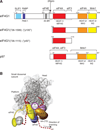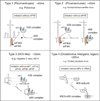The mechanism of eukaryotic translation initiation and principles of its regulation
- PMID: 20094052
- PMCID: PMC4461372
- DOI: 10.1038/nrm2838
The mechanism of eukaryotic translation initiation and principles of its regulation
Abstract
Protein synthesis is principally regulated at the initiation stage (rather than during elongation or termination), allowing rapid, reversible and spatial control of gene expression. Progress over recent years in determining the structures and activities of initiation factors, and in mapping their interactions in ribosomal initiation complexes, have advanced our understanding of the complex translation initiation process. These developments have provided a solid foundation for studying the regulation of translation initiation by mechanisms that include the modulation of initiation factor activity (which affects almost all scanning-dependent initiation) and through sequence-specific RNA-binding proteins and microRNAs (which affect individual mRNAs).
Figures







References
-
- Pestova TV, Lorsch JR, Hellen CUT. In: Translational Control in Biology and Medicine. Mathews MB, Sonenberg N, Hershey JWB, editors. New York: Cold Spring Harbor Laboratory Press, Cold Spring Harbor; 2007. pp. 87–128.
-
-
Unbehaun A, Borukhov SI, Hellen CUT, Pestova TV. Release of initiation factors from 48S complexes during ribosomal subunit joining and the link between establishment of codon- anticodon base-pairing and hydrolysis of eIF2-bound GTP. Genes Dev. 2004;18:3078–3093. 2004. This biochemical study shows that eIF1 is a negative regulator of hydrolysis of eIF2-bound GTP which inhibits the commitment step in initiation until codon–anticodon base-pairing is established: eIF1 thus ensures the fidelity of initiation both after and during scanning
-
-
- Fraser CS, Berry KE, Hershey JW, Doudna JA. eIF3j is located in the decoding center of the human 40S ribosomal subunit. Mol. Cell. 2007;26:811–819. - PubMed
Publication types
MeSH terms
Substances
Grants and funding
LinkOut - more resources
Full Text Sources
Other Literature Sources

